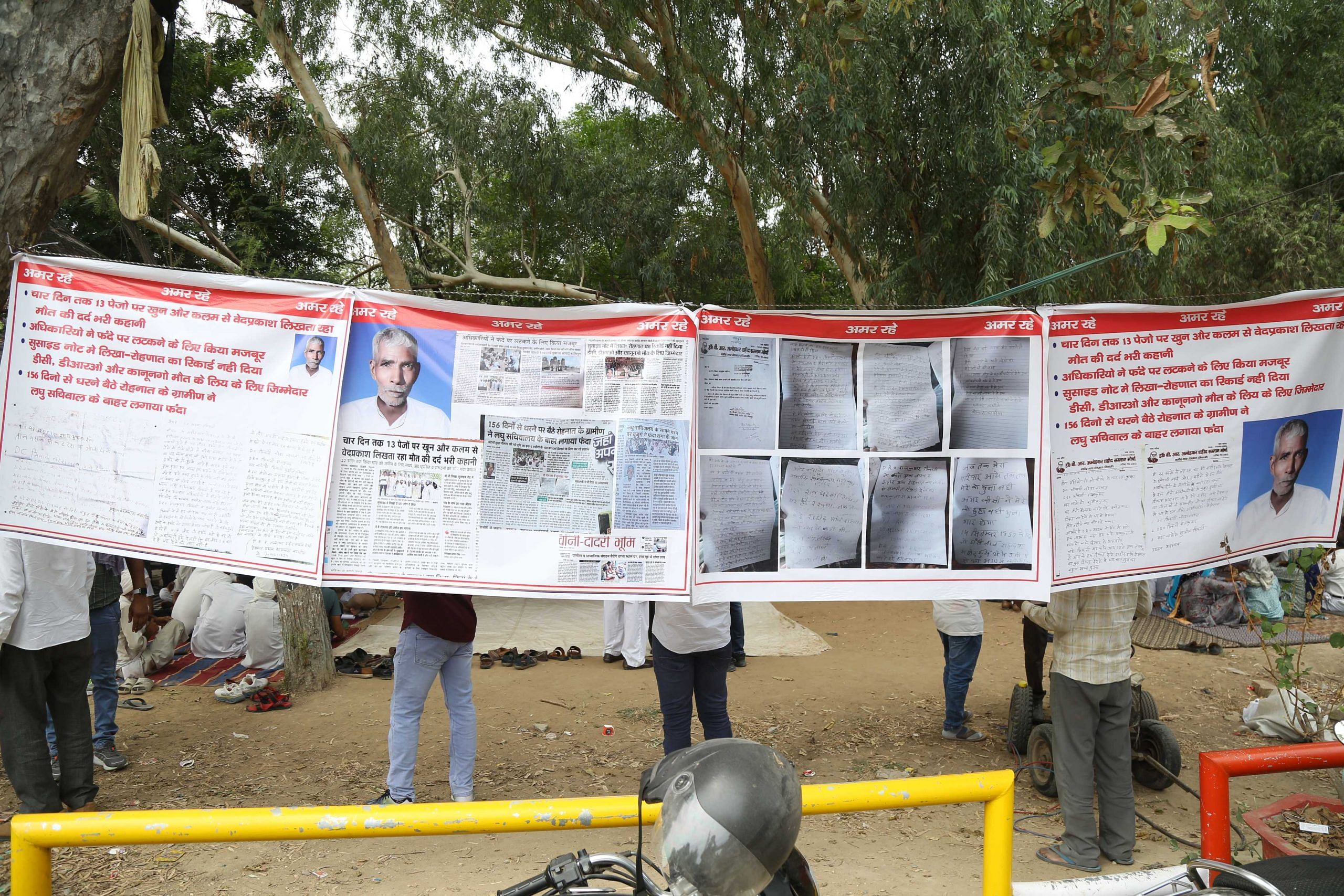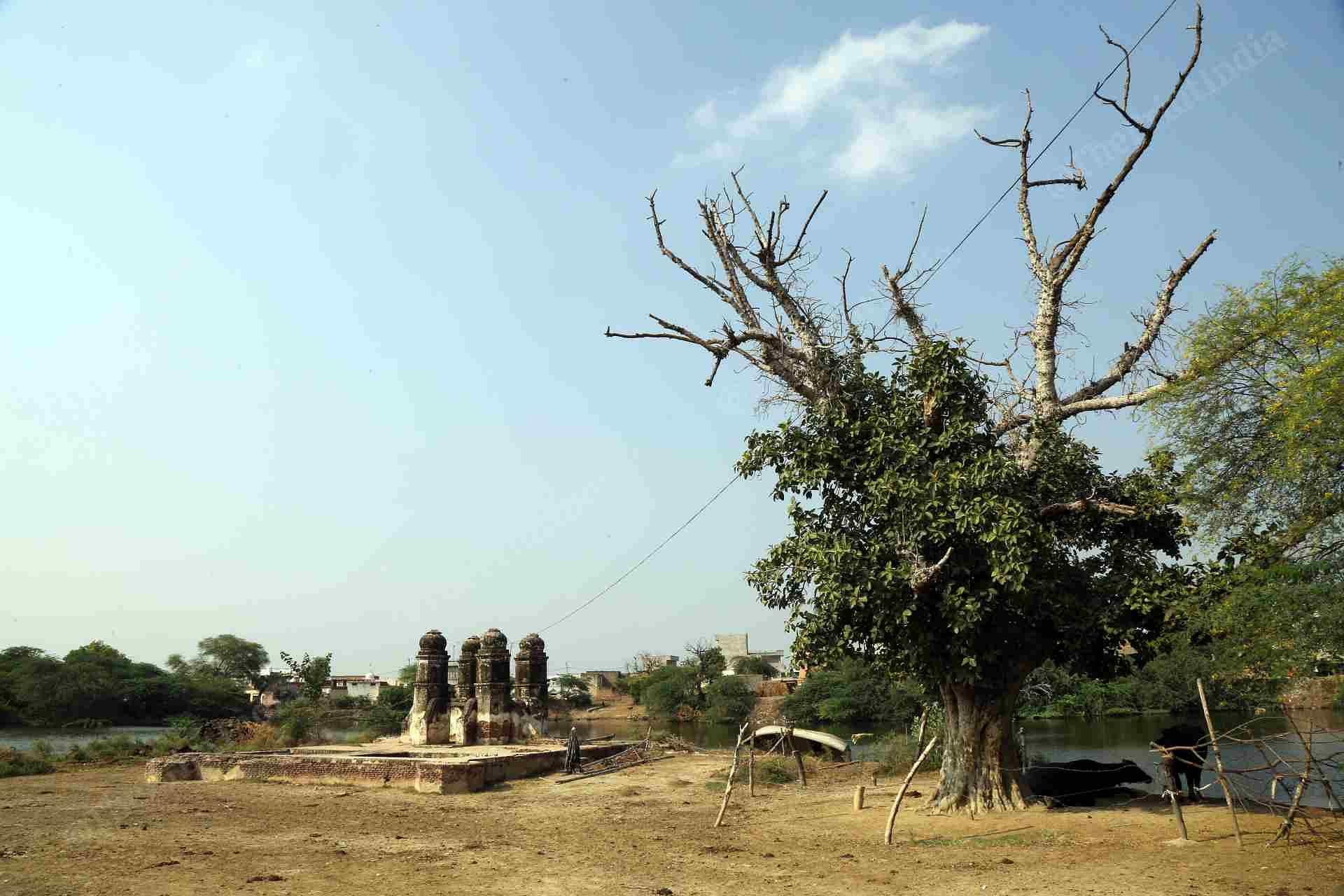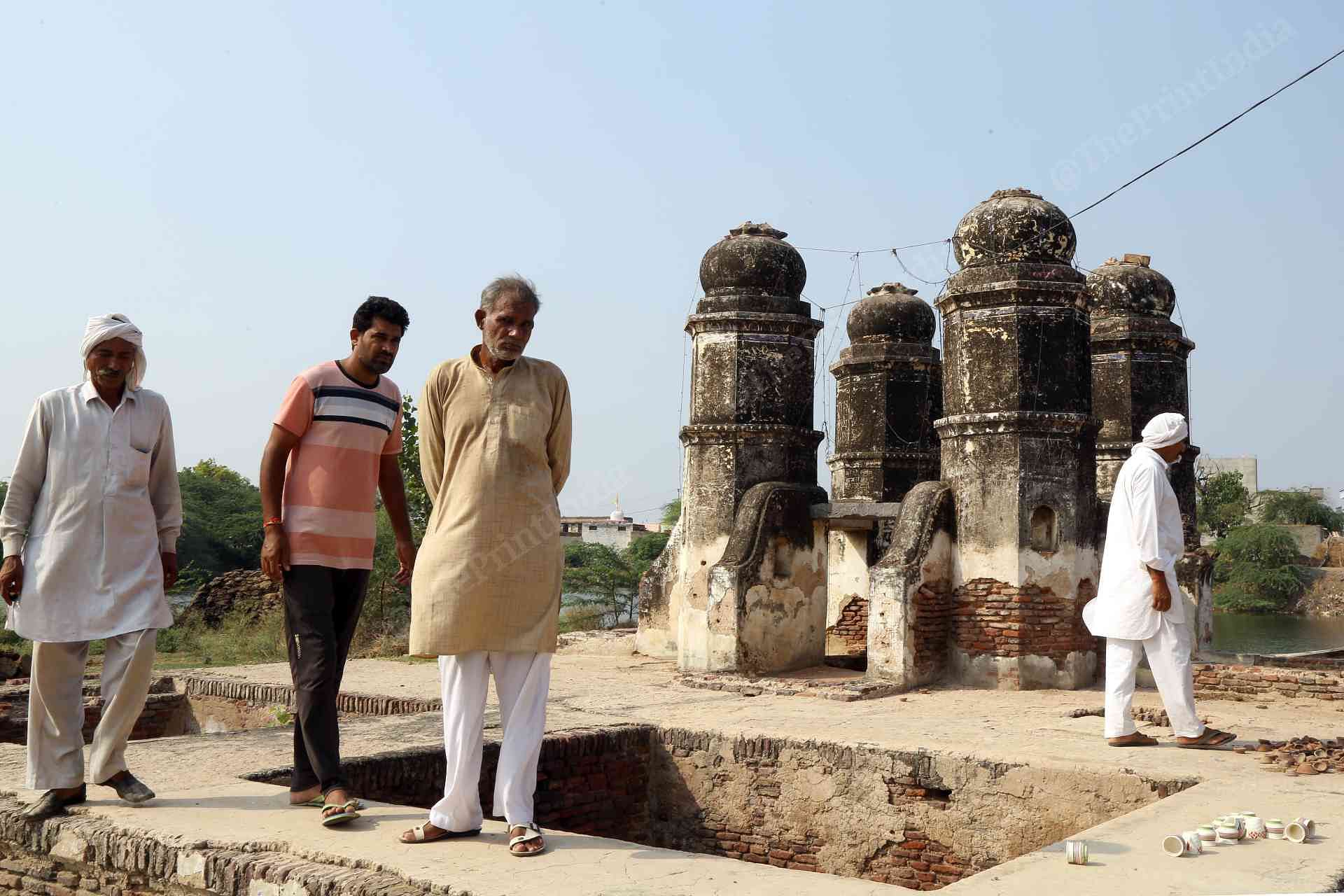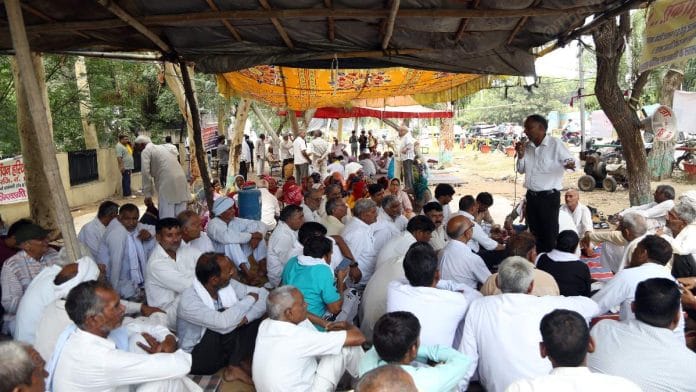Rohnat (Bhiwani): Last Tuesday, a resident of Haryana’s Rohnat village hanged himself from a tree outside the Bhiwani mini secretariat. The ensuing furore has once again brought into focus a painful chapter for this village, which paid a bloody price — from public hangings to people being crushed by road-rollers — for its participation in the 1857 war of independence.
Rohnat was declared a “village of rebels” by the British in the aftermath, and the residents’ private and panchayat land confiscated and auctioned.
Over 166 years later, the village still feels the stigma of the tag, and the battle for the lost land continues — and it’s against this backdrop that Ved Prakash ended his life last week.
Since Independence, many politicians have promised the villagers that the sacrifices of their forefathers won’t go to waste, but nothing much has happened on the ground, residents told ThePrint.
Since 10 May, the anniversary of the 1857 uprising, Rohnat residents have been on an indefinite dharna outside the Bhiwani mini secretariat. Their demands include a ‘village of martyrs’ status for Rohnat and land “as promised by governments since 1966”, said Pradeep Kaushik, president of the Rohnat Shaheed Smarak Committee, which is spearheading the dharna.
In a purported suicide note, Ved Prakash is learnt to have held Deputy Commissioner Naresh Narwal, District Revenue Officer Raj Kumar, and Sadar Kanoongo, a revenue official above the rank of village-level revenue official (patwari), responsible for his death.
“I have been meeting these officials with some of my fellow villagers for the past three months with a request to provide us with some documents related to our village, but they have been harassing me instead,” Ved Prakash alleged in the letter.

A week since his death, the villagers sitting on dharna have refused to cremate Ved Prakash until their demands are met.
Negotiations were under way until Tuesday, but the two sides had not found common ground.
ThePrint tried to meet Deputy Commissioner Naresh Narwal at his office in the Bhiwani mini-secretariat last week, but he was not available.
Bhiwani Superintendent of Police (SP) Varun Singla said they had received a complaint with regard to the suicide, but added that the note purportedly left behind by Ved Prakash was being investigated on account of certain “irregularities”.
With Ved Prakash’s family so far refusing to claim the body, it is lying in the mortuary of the civil hospital, he added.
The role played by Rohnat in the 1857 war is something villagers hold close to date, and stories about the feat have been passed down generations.
Speaking to ThePrint, residents described how the battle to reclaim their land has been a journey of frustration spanning decades. The fact that Independent India has failed to free them from the burden of the British crackdown is a source of much resentment, they said.
Also Read: From Galouti kebabs to the uprising of 1857—Wajid Ali Shah left an indelible mark on India
The saga of Rohnat
According to the book History of India by Malti Malik — former professor in the Department of History at the Faridabad-based Jawaharlal Nehru Govt Postgraduate College — Gurgaon, Rohtak, Sirsa, Hisar, Rewari, Panipat, and Thanesar in present-day Haryana were the epicentres of the revolt against the British in 1857.
Dharambir Fauji, a retired serviceman from Rohnat, told ThePrint that the village was at the forefront of the revolt against the British regime after the 1857 war began in May.
“On 29 May 1857, the revolutionaries from Rohnat attacked the government treasury at Tosham, situated at a distance of 19 kilometres from the village, and plundered it. Later, they attacked a jail in Gujri Mehal at Hisar and freed several revolutionaries imprisoned there,” said Fauji.
“Eleven British officers were killed at Hansi and 12 at Hisar by revolutionaries led by villagers from Rohnat. The group included residents of nearby villages such as Putthi Mangalkhan, Mangali, Hajimpur and Jamalpur,” he added.
Fauji said the crackdown that followed was brutal and relentless.
“Armed soldiers on horses under Platoon 14 surrounded the village. Cannons were stationed around the village boundaries. First of all, the three villagers who led the rebellion, Birhad Bairagi, Naunda Jat and Rupa Khati, were tied to the [mouth of] cannon barrels and blasted in full public glare. Their bodies spread over the fields in pieces,” he said.
After this, he added, “men were taken from their homes and hanged from an old banyan tree near the village pond”.

Later, more than a hundred revolutionaries, including 14 from Rohnat, were crushed under a road-roller in the nearby town of Hansi, said Fauji. “The road on which the villagers laid down their lives is still named ‘Laal Sadak’,” Fauji added.
The well into which women and children are believed to have jumped still exists, surrounded by a concrete boundary, its water now green from algae.

“We don’t know how many women and children died in this well. But we have learned from our elders that the well was filled with dead bodies,” said Navneet Kumar, a youth in his 30s from Rohnat.
The British, villagers said, subsequently filled the well with soil “to ensure that the residents didn’t have water to drink”.
There was more to come, however.
On 14 September 1857, the then deputy commissioner of Hisar — William Khwaja — wrote to the tehsildar that the village had been notified as a “village of rebels”, and hence its property should be confiscated and auctioned, said Fauji.
“On 20 July 1858, as many as 20,656 bighas and 19 marlas of private and panchayat land of the village was auctioned for Rs 8,100, leaving the villagers with no land of their own or of the collective ownership of the village,” said Fauji. “Only 13 bighas and 10 biswa of land, where the village pond and well are located, was kept out of the auction.”
Bigha is a unit of area used in South Asia and its definition varies from region to region. In Haryana, one bigha is equivalent to 0.619 acres. Marla is another local unit but with a standardised definition — 1 acre has 160 marlas. One biswa — another local unit with a varying definition between different areas — is equal to 4.96 marlas in Haryana.
“It was during the subsequent years that the survivors among our ancestors worked hard and purchased some land, and hence some families have agricultural land today,” said Fauji.
Kumar added that the size of the landholdings is still small — most villagers, he said, have two acres or less agricultural land left with them, partially due to their size dwindling from inheritance and largely because the landholdings were small to begin with.
Om Prakash ‘Comrade’, a Leftist leader who has been supporting the agitation by Rohnat village, said the villagers had never hoisted the Tricolor on Independence Day or Republic Day since 1947.
Added Ravinder Boora, husband of former village sarpanch Renu Boora, “How can we do that when a draconian order passed by the British regime is still being implemented on us? We are still nicknamed the ‘village of rebels’ and we have not received our lands back either.”
The only time the national flag was unfurled in Rohnat, he added, was on 23 March 2018, to mark ‘Shaheed Diwas’, which is observed to remember the sacrifice of freedom fighters Bhagat Singh, Rajguru and Sukhdev. Chief Minister Manohar Lal Khattar had visited the village that day, he said.
“We gave him a list of demands, including removing the ‘village of rebels’ tag and notifying Rohnat as ‘village of martyrs’. However, nothing has happened so far and hence the dharna outside the mini-secretariat,” said Boora.
In the context of ongoing issues in Haryana, the recent discussions around the Haryana budget highlight the government’s approach to addressing local needs and historical grievances.
The book Shaheed Gaon Rohnat (Martyr Village Rohnat), authored by Jagdish Bharti from Hansi, Pandit Jagat Swaroop Advocate from Hisar and Bhalle Ram Boora from Rohnat, offers details about the farmers whose land was auctioned, and includes all the subsequent communications between the government and the villagers.
According to the book, accessed by ThePrint, the ‘bandobast’ — or settlement of land in revenue records — was held in 1840, which was given the shape of an ‘ikrarnama’ or bond on 8 July 1841. The bond identified villagers as ‘malikaan’ or ‘owners’, and ‘maurusi mujaras‘ or ‘tenants with occupancy rights’.
The list shows 34 villagers as land owners in 1841, 17 years prior to the auction, while nearly 20 others were shown as ‘marusi mujaras’ of agricultural land.
In most cases, the second name of the villagers was not mentioned in the list published in the book.
Partap Singh Kairon’s assurance in 1964
According to Fauji, the first leader of Independent India to take note of their demands was former Punjab CM Partap Singh Kairon, who served in the post from 1956 to 1964.
“He told us that our land couldn’t be returned to us because of legal implications, but offered to give us 57 plots of 12.5 acres each in Hisar Bir area. The villagers gave their consent to Kairon’s offer, but nothing happened,” he added.
Shaheed Gaon Rohnat contains a letter dated 23 September 1966, written by the Hisar deputy commissioner to the Punjab additional chief secretary, and titled “Confiscation of land of village Rohnat, district Hisar during 1857 movement. Request for restoration”.
“Reference to your memo — dated 12 August 1966, on the above subject. There is no land available in the Hansi subdivision of this district for allotment. However, 57 plots detailed below are available in Hisar Bir. These can be allotted to the applicants if the government so decides,” said the letter.
On 15 October that year, the additional chief secretary replied.
“Before proceeding further with the examination of the matter, the government would like to know whether the applicants have been consulted and they are agreeable to accept land in Hisar Bir instead of Hansi subdivision. If not, the sarpanch, Rohnat, be consulted now and the willingness in writing of the applicants be conveyed at an early date.”
The Hisar deputy commissioner wrote back on 20 October 1966 that the consent of the applicants, duly attested by the sarpanch, was being enclosed “for favour of action at your end”.
In the meantime, Haryana was carved out as a separate state from Punjab on 1 November 1966.
On 1 December 1966, the Hisar deputy commissioner wrote another letter to the Punjab additional chief secretary under the same subject. “Order passed in the above-noted case may kindly be intimated early,” he wrote.
As Haryana chief minister, Bansi Lal, who happened to be from the nearby Tosham assembly constituency of Bhiwani and served four terms between 1968 and 1999, offered Rs 64.32 lakh as compensation to the villagers instead of land, Fauji said.
“The villagers agreed to the proposal, but only Rs 1.25 lakh was distributed among 25 families and the process was stopped after that,” he added.
Fauji’s claims are substantiated by a letter written to the financial commissioner and principal secretary (revenue department) by the then deputy commissioner of Bhiwani, Hardeep Singh, on 20 May 1992.
Written in Hindi, the letter said that, after going through files, Hardeep Singh had found out about the government’s offer of 57 plots and that they had not been distributed despite the villagers’ consent.
In 1970, the letter added, a compensation of Rs 64.32 lakh was announced, but only Rs 1.25 lakh distributed among 25 people.
The deputy commissioner recommended better compensation — or alternative land — for Rohnat families affected by the auction.
In 1986, Bansi Lal was also reminded of his promise by Amar Singh Dhanak, a minister in his cabinet, through a letter dated 31 December.
“A symbolic compensation of Rs. 1.25 lakh was distributed among farmers in 1970 when you were the chief minister. Now, since you have become the CM again, I not only hope but trust that you will get the old papers dug out from the files, and ensure that the villagers got their due. This will be doing honour to the martyrs of 1857,” Dhanak wrote.
On 24 August 1994, Jangbir Singh, an MP representing Bhiwani for the Haryana Vikas Party (floated by Bansi Lal after quitting the Congress), discussed the issue in the Lok Sabha.
Narrating what had happened to the villagers in 1857, Jangbir Singh requested the central government to provide Rs 64.32 lakh to the Haryana government for distribution among Rohnat villagers “because the state government is unable to do this because of a paucity of funds”.
None of the promises has materialised.
Also Read: Did the Scindias betray India? The 1857 revolt and the ‘truth’ in Congress’ jibe
‘Suicide note’ being investigated
When Haryana CM Khattar visited Rohnat on 23 March 2018, he announced, according to media reports at the time, a ‘shaheed smarak’ — a ‘memorial for martyrs’ — to be built on four acres of land, free medical treatment for all villagers above the age of 60 and Rs 1 crore to a trust for making a film on the history of the village.
“The CM accepted our charter of demands and assured us that we can consider all our demands accepted,” said Pradeep Kaushik of the Rohnat Shaheed Smarak Committee.
“However, nothing has been done so far. Even the ‘shaheed smarak’ is being built at a very slow pace. This is the reason we started this dharna, which is now more than 160 days old,” he added.
At the site of the memorial, ThePrint saw that only work on four walls has been completed so far. Four labourers were working on its gate at the time.
Kaushik said they had held a dharna earlier as well, in August 2022, and a villager named Sant Lal had died during the protest. It was ended after Sant Lal’s family was given a part of the compensation sought, he added.
Meanwhile, SP Singla said the purported suicide note left behind by Ved Prakash — allegedly blaming officials — is being investigated.
“We have registered a daily diary report (DDR) in connection with the suicide and begun inquest modalities. So far as the suicide note is concerned, we have found a number of irregularities in it,” he told ThePrint.
“One of the pages is undated while the other carries the date of 8 September 2023, four days before the alleged suicide. The note shows multiple inks. The victim was in the habit of writing suicide notes and using it to pressure the authorities. He did this once in August too. No documents have been provided to substantiate the allegations levelled in the suicide note,” he added.
All these facts, he said, “cause doubts on the veracity of the note”.
“We have decided to send this to handwriting experts, and forensic experts and also seek legal opinion. We have also sought the handwritten papers of the victim so that the handwriting could be matched. We will take action on the complaint by the family once we receive the reports,” he added.
(Edited by Sunanda Ranjan)
Also Read: 1857 war, INA trials to PM’s speech — why Red Fort is an enduring symbol of India’s freedom struggle






